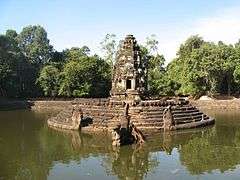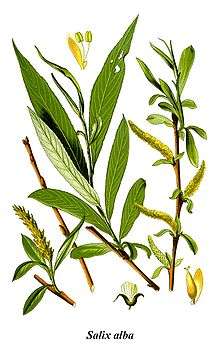Traditional Cambodian medicine
| This article is part of a series on |
| Alternative medicine |
|---|
 |
|
Fringe Medicine and Science |
|
Traditional Cambodian medicine comprise several traditional medicine systems in Cambodia.
Healers and herbalists of Cambodian traditional medicine are collectively referred to as Kru Khmer. There are many regional variations of the practice and herbal knowledge of traditional medicine within Cambodia. Traditional Cambodian medical practices are widely used in Cambodia.
Even though health is among the Cambodian governments five most important issues, the healthcare system in the country is inadequate and people in more remote villages in the provinces have difficulty obtaining health care. This situation is reflected in many developing countries and, in part for this reason, the World Health Organization (WHO) is promoting the use of and preservation of knowledge of several traditional medicines in many of these areas across the globe, including Cambodia.[1]
Because of the ethnic Chinese and ethnic Vietnamese populations of Cambodia, traditional Chinese medicine and traditional Vietnamese medicine are also practiced and represented in the country.
Techniques and culture
Practitioners of traditional Cambodian medicine are called Kru Khmer (or alternately kru khmae), meaning "Khmer teachers", and the teacher-student aspect between practitioner and patient is of central importance to the consultation. Kru Khmers specialise in several categories, such as bone setting, herbalism or divining. Various animal parts, minerals and tattoos are sometimes involved.[2] In the framework of traditional Cambodian medicine, the supernatural world can both cure and cause illness and therefore the definitions between what is medicinal and what is spiritual is often blurred.[3]
Khmer traditional medicine share with Chinese traditional medicine three explanatory models of disease: supernaturalistic theory, naturalistic theory, and maintenance of a hot-cold (yin-yang) balance. Four forms of therapy are delivered by medical and para-medical personnel: spirit offerings, dermabrasion, maintaining hot-cold balance, and herbal medicines.[4]
The knowledge of Khmer traditional medicine is mediated from teacher to teacher. Each Kru Khmer answers to his individual teacher, called Kru Khom, through a spiritual connection, even after the death of his Kru Khom. There are intricate rules and rituals involved in this relationship.[2]
Khmer traditional medicine used to rely on written texts, Khmer sastras or palm-leaf manuscripts, since the 9th century, stored and studied at the many temples across the former Khmer Empire. However, during the Cambodian civil war and the following Khmer rouge regime, virtually all historic scholarly texts and philosophical literature in Cambodia were destroyed, including many Khmer medical manuscripts.[2]
To understand the profession and practice of the Kru Khmer in more detail, the profession may be divided into a number of sub-classifications, each tied to a specific method, affliction of attention and/or service provided.[5]
- Kru thnam (or kru phsom thnam) means "combine medicine" and comprise traditional herbalists.
- Kru bakbeg (or kru to chhang) means "broken" (or "connect bone"). These are bone-setters using various herbal concoctions in bandages.
- Kru teay are diviners and fortune-tellers. Methods range from astrological charts and mantras to herbs and blowing (sdoh phlom).
- Kru sneh means "charm" and these kru khmers makes "love medicine" or charms to be used for general luck.
- Kru son thith are diviners with permanent access to some special spirits. They are supposed to divine the course of certain diseases and sometimes use herbs too.
- Kru thmup are sorcerers said to cause illness or inflict evil upon people. Broadly despised and feared in traditional Cambodian culture and viewed as evil themselves, no kru khmer would admit to be or practise thmup. To cure evil inflicted by thmup one would need the help from a kru teay, kru son thith, kru chol rup or a Buddhist monk.
- Chol rup (or kru chol rup, kru boramey), meaning "enter body", are possessed spirit mediums, often female. They are able to perform diagnosis or exorcisms.
- Buddhist monks plays a role in the practice of traditional Cambodian medicine, as they perform exorcisms, mostly preventive exorcisms.
- Chhmob boran are midwives who, under the guidance of a personal spirit, performs nursing and ritual assistance for mother and child during and after delivery.
Individual Kru Khmer healers may perform several roles altogether.
History

The exact origins of traditional Khmer medicine (TKM) remains unclear, but it is believed to have been founded and formalised in the 9th century, during the Angkorian period, influenced by Ayurveda (traditional Indian medicine) and traditional Chinese medicine. These foreign frameworks and practices were mixed with local beliefs and superstitions to create the foundations of TKM. The temple of Neak Poan is believed to have been the central temple for Khmer medicine during the Angkorian era. Jayavarman VII, who reigned c.1181–1218, ordered the construction of 102 hospitals (‘halls of diseaselessness’ or arogyasala) throughout his realm. The knowledge and practice of TKM was written down on palm-leaf manuscripts, written in the pali language, and stored in temples all over the empire. Most of these original Khmer medicinal manuscripts are thought to have been destroyed in the Cambodian civil war, but some still exists and they represent some of the most reliable sources to the origins of TKM.[3][6]
Surviving ancient Khmer medical texts shows a considerable systematization of medical knowledge, but an institutionalized Khmer medical system with associated doctrine-based practices, did not survive into the modern age in Cambodia. Scholars and historians have long wondered what happened to this grand medical tradition and the 13th century is considered a crucial tipping point in the history of traditional Khmer medicine. The gradual decline of the Angkorian Empire and the religious shifts to Theravada Buddhism appears to have affected the original medical culture greatly. The Siamese conquest of Angkor is not thought to have destroyed the medical traditions, but rather appropriated the medical knowledge and preserved it as Thai instead of Khmer. The French colonial era is also thought to have affected and prevented the rise of the ancient Khmer medical tradition. Unlike India for example, where dialogue and knowledge exchange between initial colonialists and Indian doctors took place, the colonial presence beginning with the 18th century in Cambodia was almost instantaneous and the French demanded and relied upon Western medicine from the very start, abolishing the local Cambodian medical traditions altogether. The following independence and warring upheaval of Cambodia during the civil war, the Khmer Rouge regime and the Vietnamese occupation, all continued this suppression of medical traditions, in particular the spiritual aspects. This centuries long pressure have resulted in fragmenting the Khmer medical tradition, sometimes with local reinventions emerging.[6]
Historically, three sub-categorizations of the Kru Khmer profession have been noted: kru pet, kru thnam and tmup. Kru pet were the most revered and theoretically educated. They studied the palm-leaf manuscripts in temples and were mostly found around the royalty's residences and temples, less so among the general population. Kru thnam, who were herbalists without much interest in religious aspects, were much more numerous and to be found throughout the country. Tmup were sorcerers.[7]
- Notable Kru Khmers
Yajnavaraha was a religious Kru Khmer and royal physician of the Khmer Empire in the 10th century. Along with Khmer traditional medicine he also practiced Ayurveda, an Indian traditional medicine system.
Centers and organizations
A Traditional Medicine Research Center was opened in 1982, and in 1983 production of selected medicines began and a number of books on healing plants have been published. Specialists in Cambodian traditional medicine have been brought to the Faculty of Medicine for conferences and one of the faculty's goals is to introduce traditional medicine in all curricula at primary, secondary, and university levels.[8]
In 2009, the National School of Traditional Medicine opened in Phnom Penh. The school teaches and collects knowledge of traditional medicine in Cambodia, usually referred to as Khmer traditional medicine.[9][10] The school has a special focus on hygiene and anatomy.[11]
Laws and regulations
Regulation of herbal medicines in Cambodia was introduced in 1998. Herbal medicines are regulated as over the counter medicines and for self medication only. By law, no claims may be made about herbal medicines.[12]
The regulatory requirements for manufacturing or safety assessment, and the control mechanisms established to ensure compliance, come under the Department of Drugs and Food. As of 2005, there are 48 registered herbal medicines in Cambodia; however, none of them are included on a national essential drug list.[12]
Herbal medicines in Cambodia are sold in pharmacies as over the counter medicines, in special outlets, by licensed practitioners and without restriction.[12]
See also
Sources
- Maurice Eisenbruch (1992). "The Ritual Space of Patients and Traditional Healers in Cambodia". Bulletin de l'Ecole française d'Extrême-Orient. 79.2: pp. 283-316.
- Ashwell, D. and Walston, N. (2008). "An overview of the use and trade of plants and animals in traditional medicine systems in Cambodia" (PDF). TRAFFIC Southeast Asia.
- J. Ovesen and I. Trankell (2010). Cambodians and Their Doctors (PDF). NIAS Press.
- Kent Maynard (2007): Medical Identities, Berghahn Books
- Journal of Complementary and Integrative Medicine (July 2010): Traditional Cambodian Medicine
- The Nippon Foundation: Turning a Country of Land Mines into a Country of Medicine: A New Role for Traditional Herbalists in Cambodia
- Nomad Recherche et Soutien International (2011): Traditional therapeutic knowledge of the Bunong People in North-eastern Cambodia: Healers, their practices and medicinal plants
References
- ↑ See "National Policy on Traditional Medicine and Regulation of Herbal Medicines - Report of a WHO Global Survey"
- 1 2 3 See Kru Khmer (p.52 f) in Medical Identities.
- 1 2 See the TRAFFIC report.
- ↑ See "Traditional Cambodian Medicine"
- ↑ See "Cambodians and Their Doctors", p. 134-6.
- 1 2 See "Cambodians and Their Doctors", p.129-33.
- ↑ Described by Adhémar Leclère in 1894. See "Cambodians and Their Doctors", p.133.
- ↑ "Health Care in Cambodia". Cultural Survival. 1990. Retrieved 15 November 2016.
- ↑ "Opening of School for Khmer Traditional Medicine". The Nippon Foundation. 29 April 2009. Retrieved 15 November 2016.
- ↑ Keo Kounila (10 November 2010). "Who needs modern medicine?". The Phnom Penh Post. Retrieved 15 November 2016.
- ↑ "Cambodia's Khmer healers get schooled in ancient art". Fox News World. AFP. 4 July 2013. Retrieved 15 November 2016.
- 1 2 3 "National Policy on Traditional Medicine and Regulation of Herbal Medicines - Report of a WHO Global Survey". WHO. 2005. Retrieved 15 November 2016.
